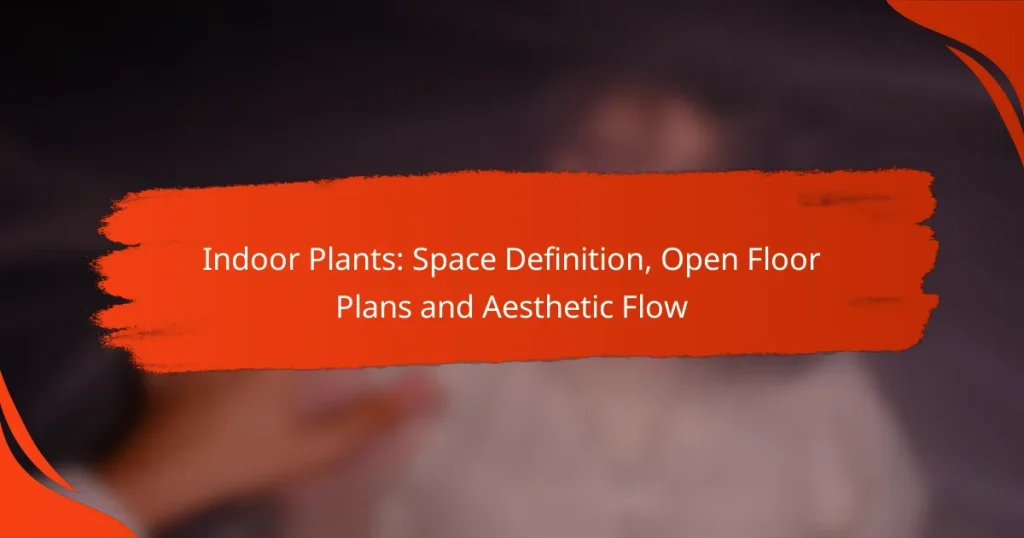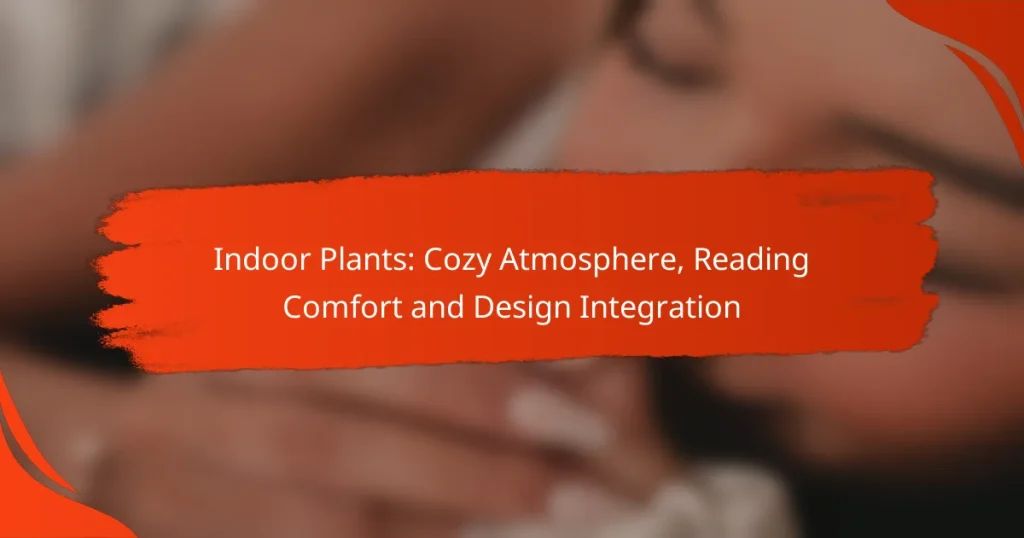Decorating with indoor plants can transform your living space by infusing it with natural beauty and a refreshing ambiance. Not only do they enhance the aesthetic appeal of your home, but they also improve air quality and create a calming environment. Selecting the right plants for your space, such as the Snake Plant or Peace Lily, can elevate your decor while being easy to maintain.
Indoor Plants: Visual Arrangement, Impactful Design and Aesthetic Balance
Indoor Plants: Creative Decor Ideas, Aesthetic Enhancements and Space Utilization
Indoor Plants: Cozy Atmosphere, Reading Comfort and Design Integration
How can indoor plants enhance home decor?
Indoor plants can significantly enhance home decor by adding natural beauty and improving the overall ambiance of a space. They contribute to a fresh look while providing numerous benefits, such as better air quality and a calming atmosphere.
Improves air quality
Indoor plants are known for their ability to purify the air by absorbing toxins and releasing oxygen. Common varieties like spider plants, peace lilies, and snake plants can effectively filter out harmful substances such as formaldehyde and benzene.
To maximize air quality benefits, consider placing one plant per 100 square feet of space. Regularly dusting the leaves and ensuring proper drainage can help maintain their health and effectiveness.
Adds color and texture
Plants introduce vibrant colors and diverse textures to your home, enhancing visual interest. From the lush green of ferns to the striking blooms of orchids, there are countless options to suit any decor style.
Mixing different plant types can create dynamic arrangements. For example, pairing tall, leafy plants with smaller succulents can add depth and variety to your space.
Creates a calming environment
Indoor plants can foster a sense of tranquility and relaxation, making them ideal for spaces meant for unwinding, such as living rooms or bedrooms. The presence of greenery has been shown to reduce stress and promote a positive mood.
To create a calming atmosphere, consider using plants with soothing colors and gentle shapes, such as lavender or bamboo. Placing them near natural light sources can further enhance their calming effects.
Increases property value
Incorporating indoor plants into your home can potentially increase its market value. Well-maintained greenery can make a property more appealing to buyers, as it suggests a well-cared-for environment.
When staging a home for sale, consider adding plants to key areas like the living room or kitchen. A few strategically placed plants can create a welcoming atmosphere that attracts potential buyers.
What are the best indoor plants for decorating?
The best indoor plants for decorating are those that enhance your space while being easy to care for. Popular choices include the Snake Plant, Pothos, Fiddle Leaf Fig, and Peace Lily, each offering unique aesthetics and benefits.
Snake Plant (Sansevieria)
The Snake Plant is known for its striking upright leaves and resilience, making it an ideal choice for beginners. It thrives in low light and requires minimal watering, allowing it to adapt to various indoor environments.
Consider placing it in a corner or on a shelf to add height to your decor. Be cautious not to overwater, as this can lead to root rot; letting the soil dry out between waterings is best.
Pothos (Epipremnum aureum)
Pothos is a versatile trailing plant that can be used in hanging baskets or as a tabletop centerpiece. Its heart-shaped leaves come in various shades of green and variegated patterns, adding visual interest to any room.
This plant prefers indirect light and can tolerate low-light conditions, making it suitable for darker spaces. Regular pruning helps maintain its shape and encourages bushier growth.
Fiddle Leaf Fig (Ficus lyrata)
The Fiddle Leaf Fig is a popular statement plant with large, glossy leaves that can elevate any room’s style. It thrives in bright, indirect light and can grow quite tall, making it a focal point in your decor.
Ensure consistent watering, allowing the top inch of soil to dry out before rewatering. Be mindful of drafts and sudden temperature changes, as these can stress the plant.
Peace Lily (Spathiphyllum)
The Peace Lily is celebrated for its elegant white blooms and air-purifying qualities. It flourishes in low to medium light and prefers consistently moist soil, making it a forgiving choice for indoor spaces.
To encourage blooming, feed it with a balanced fertilizer during the growing season. Keep in mind that its leaves may droop when it needs water, serving as a natural indicator for care.
How to style indoor plants in different rooms?
Styling indoor plants in various rooms enhances the aesthetic and atmosphere of your home. Consider the light conditions, humidity levels, and space available in each room to choose the best plants and arrangements.
Living room arrangements
In the living room, larger plants like fiddle leaf figs or rubber plants can serve as focal points. Place them near windows for optimal light, or use plant stands to elevate smaller varieties like pothos or snake plants.
Group plants of varying heights and textures to create visual interest. Consider using decorative pots that complement your furniture style, and avoid overcrowding to maintain a clean look.
Bedroom plant placements
For the bedroom, opt for low-maintenance plants that improve air quality, such as peace lilies or spider plants. Position them on bedside tables or shelves to create a calming environment.
Ensure that the plants you choose thrive in lower light conditions, as bedrooms often have less natural light. Avoid placing plants directly on windowsills if they require high humidity, as this can lead to excessive moisture on surfaces.
Kitchen herb gardens
In the kitchen, consider creating a small herb garden with plants like basil, parsley, and mint. Use wall-mounted planters or windowsill pots to maximize space and ensure easy access while cooking.
Herbs generally require bright light, so place them near a window. Regularly trim the plants to encourage growth and prevent them from becoming leggy.
Bathroom humidity-loving plants
The bathroom is ideal for humidity-loving plants such as ferns or orchids. These plants thrive in the moist environment and can add a touch of greenery to your space.
Consider placing them on shelves or hanging them from the ceiling to save counter space. Ensure they receive indirect light, and be mindful of water drainage to avoid mold growth.
What are the key considerations for indoor plant care?
Key considerations for indoor plant care include understanding their light requirements, watering frequency, suitable soil types, and fertilization tips. Each factor plays a crucial role in ensuring your plants thrive in an indoor environment.
Light requirements
Indoor plants have varying light needs, which can significantly affect their growth. Some plants thrive in bright, indirect light, while others prefer low-light conditions. For instance, succulents and cacti generally require more sunlight, while ferns and snake plants can tolerate shadier spots.
To assess your space, consider using a light meter or simply observe how sunlight moves through your home throughout the day. Position your plants according to their light preferences to promote healthy growth.
Watering frequency
Watering frequency is essential for indoor plant health, as overwatering can lead to root rot while underwatering can cause wilting. A general rule is to check the top inch of soil; if it’s dry, it’s time to water. Most indoor plants thrive when watered every 1-2 weeks, but this can vary based on the plant type and environmental conditions.
Factors such as humidity, temperature, and pot size can influence how often you need to water. Always ensure that pots have drainage holes to prevent excess water from accumulating.
Soil types
The right soil type is crucial for indoor plants, as it affects drainage, aeration, and nutrient availability. A well-draining potting mix is often recommended, especially for plants like succulents and orchids that require good airflow around their roots.
Consider using a mix specifically formulated for indoor plants, which typically includes components like peat moss, perlite, and vermiculite. This combination helps retain moisture while allowing excess water to escape.
Fertilization tips
Fertilizing indoor plants provides essential nutrients that may not be available in the potting mix. During the growing season, which is usually spring and summer, applying a balanced, water-soluble fertilizer every 4-6 weeks can support healthy growth.
Be cautious not to over-fertilize, as this can lead to salt buildup and damage the plants. Always follow the manufacturer’s instructions for dilution and application rates to ensure the best results.
How to choose the right pots for indoor plants?
Choosing the right pots for indoor plants is essential for their health and aesthetics. Consider factors like size, material, and drainage to ensure your plants thrive while complementing your decor.
Size considerations
The size of the pot should match the size of the plant. A general rule is to select a pot that is 1-2 inches larger in diameter than the current pot for small plants, and 2-4 inches for larger plants. This allows for adequate root growth without overwhelming the plant.
Keep in mind that a pot that is too large can retain excess moisture, leading to root rot. Conversely, a pot that is too small can restrict growth and lead to nutrient deficiencies.
Material types
Pots come in various materials, including plastic, ceramic, and terracotta. Plastic pots are lightweight and often less expensive, making them a popular choice for beginners. Ceramic pots can be more decorative but may require more care due to their weight and fragility.
Terracotta pots are porous, allowing for better air circulation and moisture control, but they can dry out quickly. Choose a material that fits your style and the specific needs of your plants.
Drainage options
Proper drainage is crucial for indoor plants to prevent waterlogging. Ensure that the pot has drainage holes at the bottom to allow excess water to escape. If you find a pot without holes that you love, consider using it as a decorative outer pot and placing a smaller pot with drainage inside it.
Additionally, adding a layer of gravel or pebbles at the bottom of the pot can help improve drainage. Always monitor your plants for signs of overwatering, such as yellowing leaves, to adjust your watering habits accordingly.



